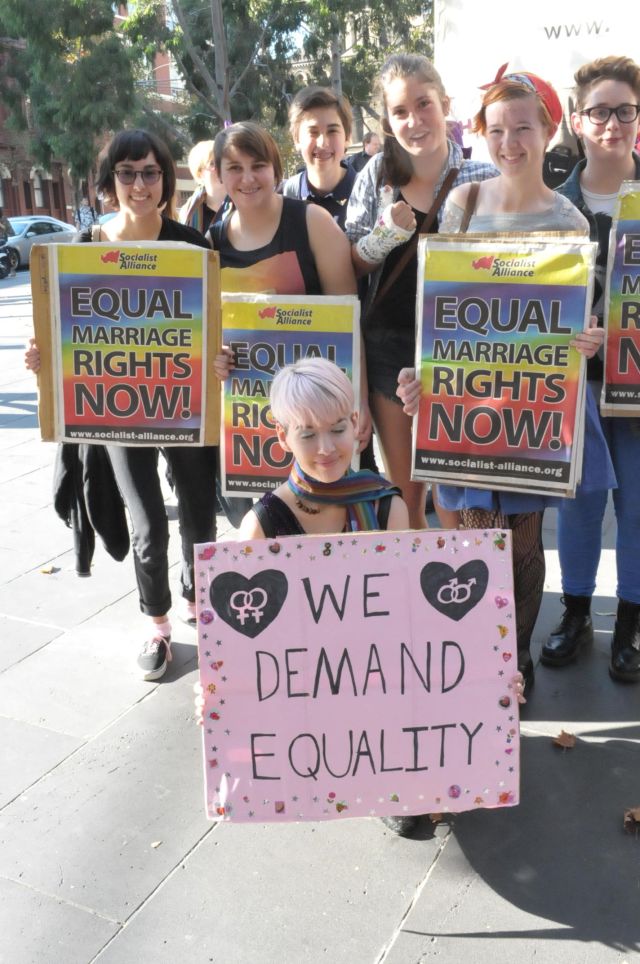
The fight against homophobia is arguably the civil rights issue of our times. It is increasingly unacceptable that, in 2013, society continues to discriminate against people based on their sexuality.
This is most obviously demonstrated by the continued refusal to grant equal marriage rights to lesbian, gay, bisexual, transgender and intersex (LBGTI) people.
Greens MP Adam Bandt is set to introduce a bill to parliament on June 8 that could end this particular discrimination. Should the bill pass, it will be a significant date in Australian history, and Australia would join 15 other nations in supporting marriage equality. France, New Zealand and Uruguay have been the most recent nations to embrace these laws.
Putting marriage equality bills to parliament is an important step forward in the campaign. But the changes should be viewed in a much larger context. Bandt is putting a bill before parliament, but it has been the actions of thousands of activists that have put the issue before the Australian people.
The former Coalition government first sparked popular protest when it rewrote the marriage act in 2004 to define marriage as between only “a man and a woman”.
Adelaide's Rainbow Youth Coalition (RYC) is an example of an activist group that formed as part of this struggle. After the Adelaide rally for marriage equality in May last year, 40 young people attended a meeting at the Adelaide activist centre. This meeting decided to form a group for young people to organise against homophobia.
Since its inception, the RYC has organised a series of protest actions, social gatherings and put out materials designed to combat homophobia. It has organised youth contingents to equal marriage protests, and been a major part of Equal Love contingents at the Adelaide Pride Parade.
RYC members Gemma Weedall, Rene Pope and Bec Andrews were invited to Gawler High School in Adelaide’s north to help the school mark the international day against homophobia (IDAHO) on May 17.
The RYC gave a series of workshops to students about homophobia, why it exists and how young people can oppose it. They encouraged students not to stand for homophobic violence in their school and to attend the youth contingent of the May 25 equal marriage rally in Adelaide.
Pope told Green Left Weekly: “When I first joined the Rainbow Youth Collective I never thought that we could get this response. It’s a powerful feeling to see young people leading the way.”
After one of the talks, a student was so inspired they graffitied “Lesbians will rule the world” on the bathroom wall. Another year-seven student came to the presenters to say thanks and ask how to get involved.
However, the RYC is just one example of many groups of campaigners that exist in every city. It’s these groups and the inspirational individuals that are their backbones that have made this change possible.
All the protests, street campaigning and Facebook arguments have marked a qualitative shift in Australian public opinion. Opinion polls in 2004 showed that only 38% of Australians supported same-sex marriage, while 44% of people were opposed.
In less than a decade, these numbers have been turned on their head. The House of Representatives’ survey last year showed that 63% of Australians supported equal marriage.
It's especially worth noting that it was young people who led the way at every step in this campaign.
It is unlikely that the marriage bill will pass the legislative assembly at this time. Many conservative Labor MPs will take advantage of a conscience vote to vote against, and Tony Abbott’s refusal to allow a conscience vote means the Coalition will wholly oppose it.
Yet as the campaign continues to move public opinion and to mobilise public anger at this injustice, the change will become inevitable. The momentum of the equal marriage campaign will clear all obstacles in its path.
The significance of this fight for marriage equality has the potential to go far beyond the rights of LGBTI people. Many of the most prominent campaigners have been LGBTI people, but a big proportion of those who have argued, petitioned and protested have been those who were not personally affected by homophobia, but who are outraged that this blatant discrimination still continues to exist.
For those who find themselves angered by injustice, the campaign for marriage equality is not just a beacon of hope but a blueprint for those who want to fight. The lesson that can be drawn from the campaign is that activists can change the world, no matter how ingrained the prejudice or how old the flawed institution.